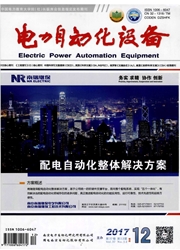

 中文摘要:
中文摘要:
为更深入地在微观角度上研究变压器绝缘纸老化机理,利用分子动力学仿真,对不同温度下纤维素无定形区的热力学性质进行了研究。结果表明:纤维素无定形区为各向同性弹性材料,其弹性系数和各模量随着模拟温度的升高均有减小的趋势,与晶区相比,温度对其影响较大;无定形区的刚性随温度升高出现较大减弱;随着温度升高,无定形区内氢键数量减少,并且分子内氢键数目较分子间氢键数目下降快。对比晶区内的氢键数目在相同模拟温度下的极小变化,可知纤维素的老化首先是从纤维素的无定形区内分子间的氢键被破坏开始的。随模拟温度的升高,纤维素分子链运动加剧,但其末端距无明显变化。温度对纤维素无定形区的力学性质和氢键的影响从分子层次上阐明了纤维素绝缘老化实验中结晶度升高及无不定形区先行老化的微观机理。
 英文摘要:
英文摘要:
In order to further understand the mechanism of transformer insulation aging in a microscopic perspective, we studied the thermodynamic property of amorphous cellulose at different temperatures based on molecular dynamic simulations. The results show that amorphous cellulose is isotropic material, and its elasticity and modulus all decrease with increasing temperature. Compared with cellulose crystal, amorphous cellulose is more obviously influenced by temperature. Plus the rigid of amorphous cellulose decrease with increasing temperature much more than that of cellulose crystalline regions. The total number of hydrogen bonds in amorphous cellulose decreases with increasing temperature, while the number of intermolecular hydrogen bonds decreases slower than the number of intramolecular hydrogen bonds at all simulated temperatures. Compare with the rather small change in the number of hydrogen bonds in cellulose crystalline regions, it is derived that the thermal aging of cellulose starts with the destruction of intermolecular hydrogen bonds in amorphous regions. Chain movement of cellulose intensifies with increasing temperature, but no significant change of end-to-end distance of cellulose chains is found. The obtained thermal impact on the mechanical properties and hydrogen bonds of amorphous cellulose illustrate the microscopic mechanism of increasing crystallinity and prior aging of amorphous regions in cellulose aging experiments.
 同期刊论文项目
同期刊论文项目
 同项目期刊论文
同项目期刊论文
 期刊信息
期刊信息
